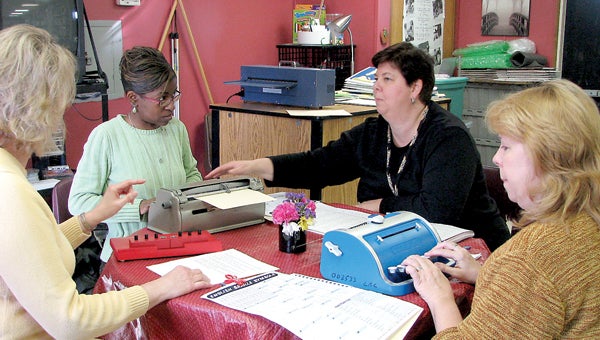Braille workshop teaches attendees reading, writing
Published 9:56 pm Saturday, April 2, 2011

Braille workshop: Attendees at a recent Braille workshop hosted by Suffolk Public Schools learn how to write Braille on special machines. Braille is a system of raised dots that stand for letters and numbers.
To Patty Brown and Karla West, more people who can teach Braille means more blind students who won’t live their lives without the ability to read and write.
With this in mind, they held the first “Braille Basics” workshops in Suffolk Public Schools last month.
“We were trying to reach some parents and (Suffolk Public Schools) staff,” West said.
At the workshops, West and Brown introduced attendees to Braille, a system of writing and reading for the blind and visually impaired that uses combinations of tangible points to represent characters, and taught them how to use it.
Braille uses different combinations of six dots to represent letters, words and punctuation, Brown said. There also is a system used to teach math in Braille, she said.
West and Brown, who are both teachers for the blind and visually impaired for Suffolk Public Schools, provided attendees of the March 28 workshop with Braille writers, which look like typewriters with only nine keys that include dots one through six, a spacebar, a backspace and a page feeder.
With Braille cheat sheets nearby, attendees Betty Cooper and Michele Mason practiced using Braille by typing their names and other familiar words.
Mason, who is a social worker at Suffolk Public Schools’ Early Childhood Center, said she attended the class because she was curious about Braille.
On the other hand, Cooper said she thought learning Braille would be beneficial for her job.
Through Southeastern Cooperative Educational Programs, Cooper works with autistic students at King’s Fork Middle School, however, she said none of her current students are visually impaired.
“It’s a pretty broad program, so I thought it would be a good thing for me to learn,” Cooper said. “With autism, it’s good to know other ways to communicate.”
At the workshop, Cooper and Mason learned two different ways to write Braille – contracted and “uncontracted.”
West said uncontracted Braille requires all words be spelled out letter by letter.
Contracted Braille, West said, shortens common words, such as about, and letter combinations, like “er.”
“Someone who reads contracted Braille will be able to read uncontracted Braille,” she said.
Using contractions as well as single letters, Brown said Braille writers can “draw” pictures to teach the blind to “see” things.
Cooper and West tried drawing on the Braille writers by following West’s instructions. When finished, they had Braille drawings of trucks.
Brown said, the drawings can be used in the classroom to teach blind students about how different objects look. She added, however, teachers have to explain the drawing is the side view of a truck, elaborating on what makes a side view different.
“There’s a lot that these kids have to learn about things,” West said.
Brown and West said they hope to have more workshops to teach Braille in the future.
West said a lack of Braille teachers is the reason there’s a 90-percent illiteracy rate among the blind.
“Unless you know the Braille code, you won’t read and write,” she said. “We’re here to see that doesn’t happen in Suffolk Public Schools.”


